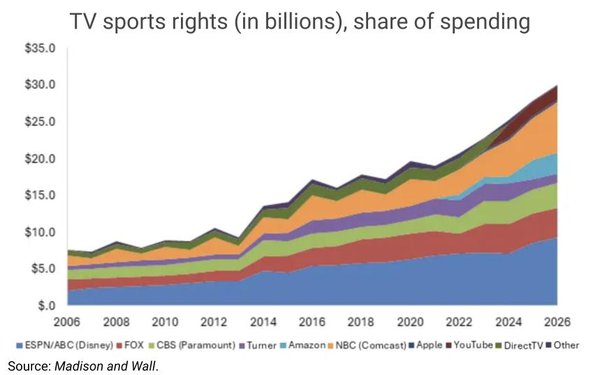
This year, sports TV content costs for TV
“packagers” are estimated to be about $35 billion -- about 40% of all money spent on programming, according to Madison and Wall.
This includes money spent by TV networks,
stand-alone premium streamers, and local TV stations on NFL, NCAA, NBA, MLB, MLS, Olympics, Golf, NASCAR, NHL, UFC, WWE, Grand Slam tennis and the WNBA -- as well as regional sports networks.
A key factor to note here, says Brian Wieser of Madison and Wall, is contrasting sports spending rights to its viewing share, “which equates to approximately 10% of linear TV measured against
all audiences, according to data from Nielsen, and presumably a smaller share of viewing of all TV including streaming services given the limited volumes of sports content on streaming
services.”
The cost-viewing disparity will grow, says Wieser. “The compounded annual growth rate on sports content spending is set to rise by an average of 7% each year for a
roughly 40% total gain in annual expenses over that time.”
advertisement
advertisement
This will mean sports-rights content costs rising to more than half of all content spent for networks, streamers and stations
by 2029. Currently, Wieser estimates $90 billion is spent per year on all content costs -- entertainment, sports and other programming.
Rising sports-rights costs in turn seem to be coming in
the wake of a projection that there could be a 14% decline in non-sports content spending over the next five years.
And that means trouble for TV networks and streamers.
“A
reduction in spending on content could circularly cause consumers to reduce their spending on video services... this could lead to very negative outcomes unless content spending budgets as a
percentage of total revenues – and thus non-sports content spending – were increased.”
A possible cure for some of this lower entertainment/content spend, says Wieser? AI,
with an artificial-intelligence process for creating non-sports content.
“Perhaps it will in fact be possible to sustain -- or even raise -- the perceived quality of non-sports content
despite reduced spending.”